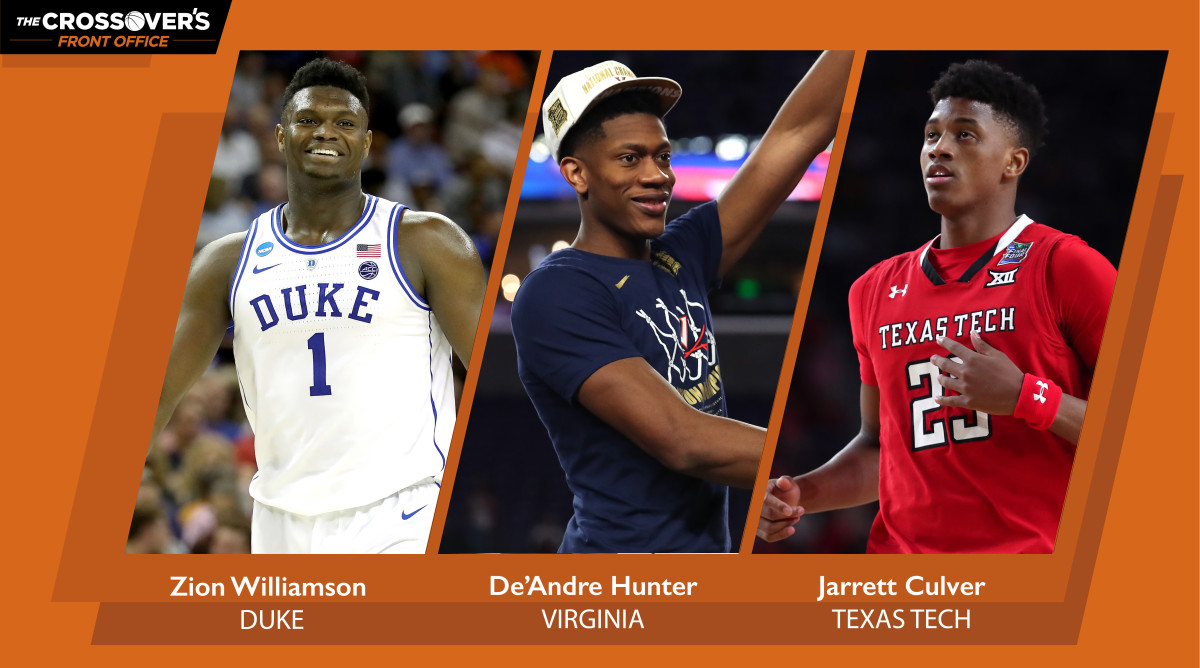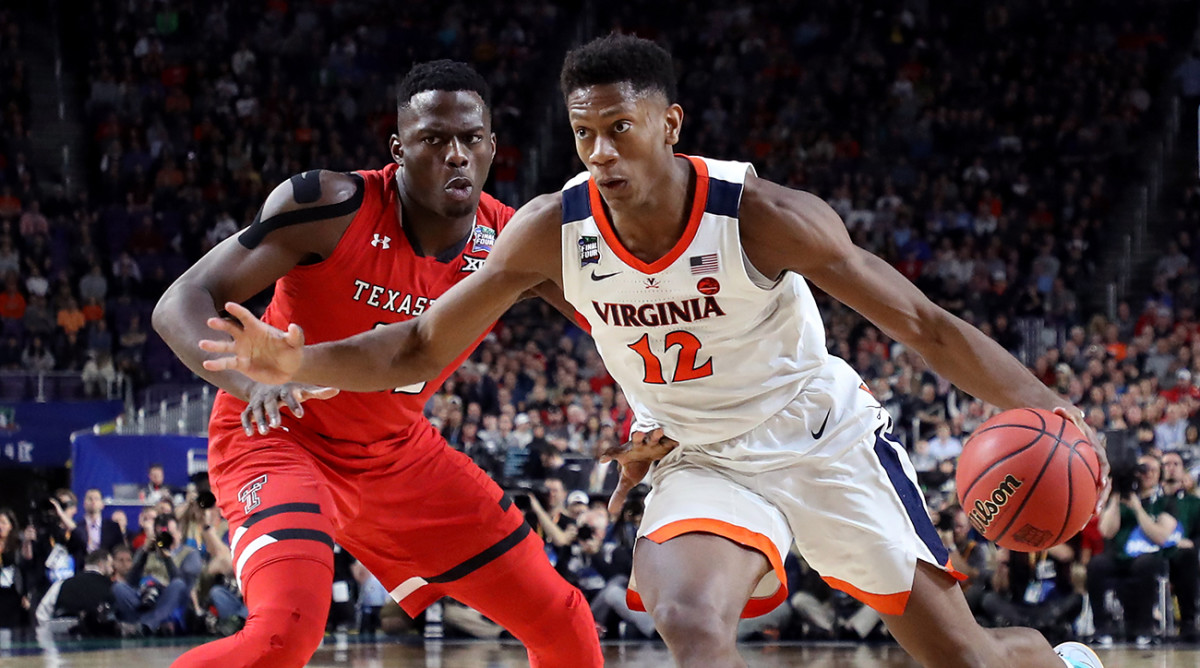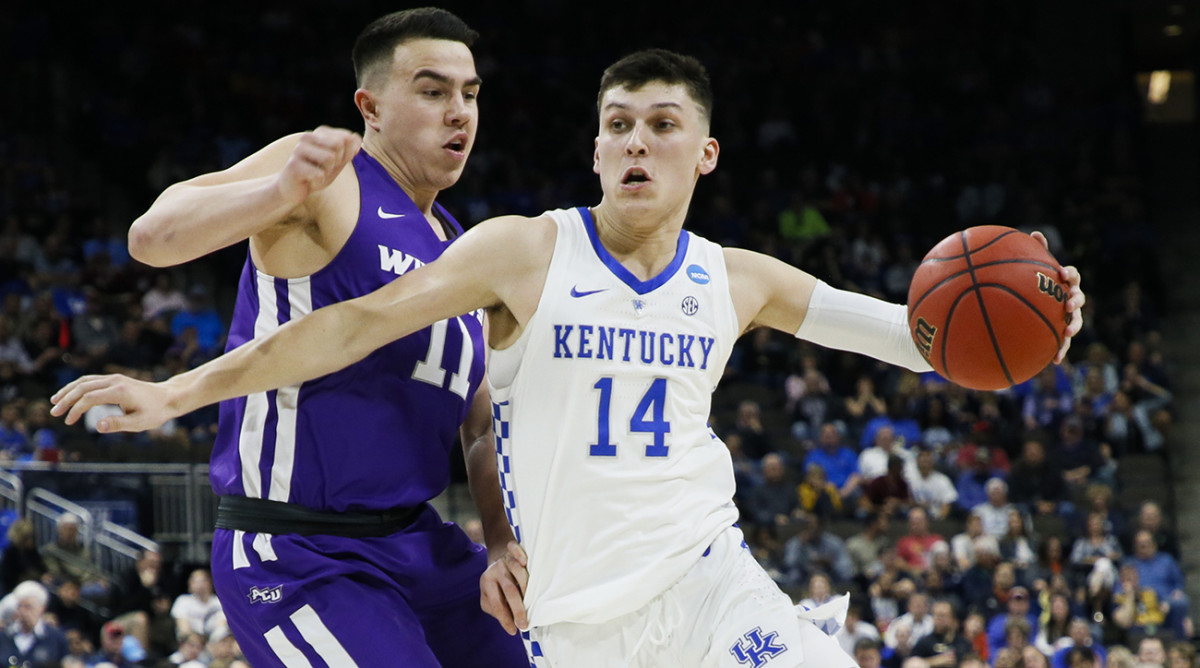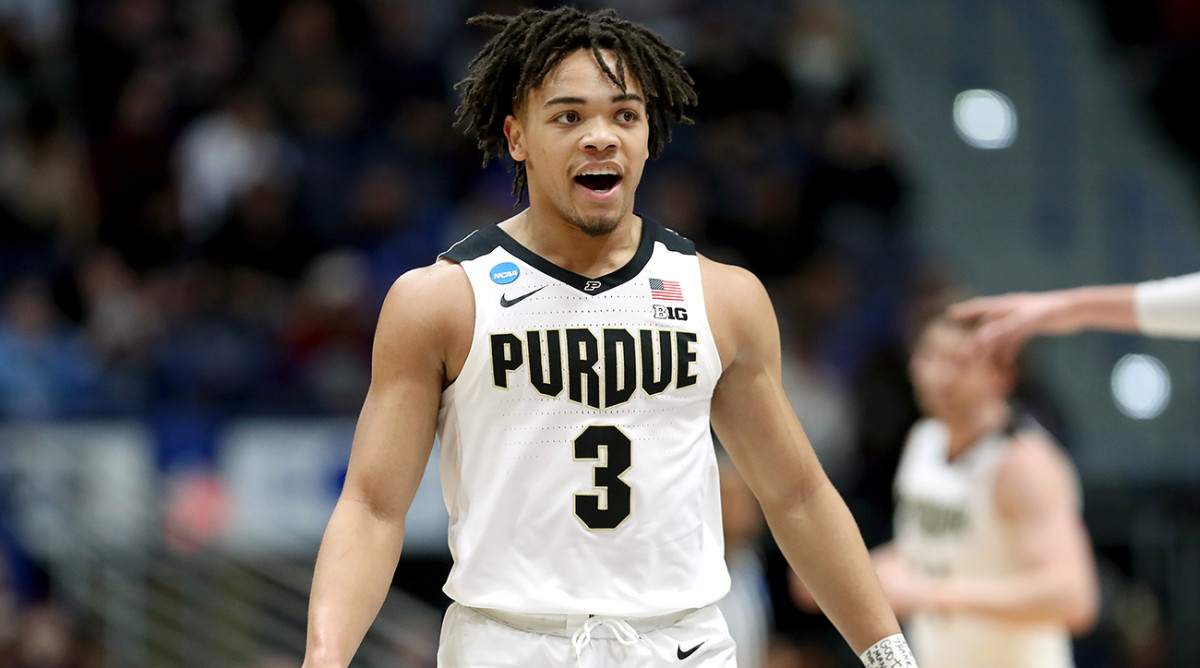2019 NBA Mock Draft 6.0: Projecting All 60 Picks After March Madness

The NCAA tournament is a wrap, which means, more or less, that this is officially draft season. And as the late Heath Ledger, as the Joker, in The Dark Knight once said: “And Here. We. Go.” Below, you’ll find the Front Office’s first full 60-pick mock draft of the year.
The early-entry deadline for this year’s draft is April 21, with the lottery set for May 14 in Chicago and the draft combine immediately following. This year, players who hire agents to help them with the draft process can still return to school, with the NCAA deadline (for college players) falling on May 29 and the NBA’s deadline (applying to international prospects and players unconcerned with their eligibility) on June 10. Other key dates are the Portsmouth Invitational for college seniors (April 17-20) and the brand-new G League Elite Camp, which will function as a precursor to the combine (May 12-14).
As always, our mock draft paints a picture of what the draft might look like if it took place on a given day. For evaluations and rankings of the available players, check out our most recent big board, a fluid, comprehensive list of the top 80 prospects.The sequence of teams is based off of the NBA standings entering Tuesday’s games.

1.

Knicks: Zion Williamson, PF, Duke
Height: 6'7" | Weight: 285 | Freshman
The Knicks are locked into having the best possible odds to win the lottery, but given the new odds structure, they’ll be on even footing with the Cavs and Suns for the top pick. Nobody can really exhale until lottery night, and even then, there will be debate over what the Knicks should do with the pick. On one hand, it’s a trade chip, and if the Knicks want to get involved with the Pelicans over Anthony Davis, winning the lottery might put that scenario in play. The flipside is that Williamson has become an attraction unto himself, and the thought of him turning into a homegrown star in New York is somewhat tantalizing (granted, the Knicks never need much help selling tickets). He has a chance to be a uniquely gifted star at the NBA level, and although there will be obstacles for him to clear, if Williamson can continue adding to his skill set and refining his jumper, there’s a sky-high ceiling for him. He just put together one of the most dominant college seasons ever, and throwing out all the hyperbole, whoever wins the lottery will be happy to re-orient their rebuild around him.
2.

Suns: Ja Morant, PG, Murray State
Height: 6’3” | Weight: 175 | Sophomore
Morant’s NCAA tournament showing should have solidified him as a top-three talent in this class for anyone who was still on the fence. While there will be some debate between him and Barrett here depending on who picks second, it’ll be tough to pass on his upside. Morant has begun to figure out just how good he can be, and while he will take his rookie lumps, as most young point guards do, he has a chance to be a legitimate star as he matures and gets stronger. For Phoenix, who are starved for talent at the point, this remains the home-run pick. And from an optics standpoint, it might be better for the roster if they end up picking second than first, which would the eliminate Morant-or-Williamson debate that seems likely to ensue, noting the Suns’ circumstances.
3.

Cavaliers: R.J. Barrett, G/F, Duke
Height: 6'7" | Weight: 200 | Freshman
The fit here between Barrett and Cleveland is not extremely neat, because trying to get him to co-exist stylistically with ball-dominant scorer Collin Sexton would be far from ideal. Still, in this situation the Cavs would probably be wise to just take a stab at upside, and Barrett will be able to score at the NBA level. If he improves his jumper and becomes a more consistently willing playmaker, he might be very good. Still, those around the league continue to express some doubt about how likely it is that he’ll alter his aggressive approach. He does not seem to care much for defense, either. While there’s a distinct possibility he continues piling up big numbers as a pro, front offices have to assess for themselves whether he’ll be able to do it at a level that eventually contributes to winning basketball.
4.

Bulls: Jarrett Culver, SG, Texas Tech
Height: 6’6” | Weight: 195 | Sophomore
An iffy performance in Monday night’s title game was somewhat discouraging, but Culver remains one of the better long-term prospects in this draft. That said, some of his limitations have been on display throughout the NCAA tournament, particularly his struggles creating off the dribble against more athletic opponents. Still, he’s mostly stepped up when needed, and his contributions go beyond scoring. To reach his potential, Culver has to continue refining his handle and jump shot, but he’s proven he can rebound, defend taller players, and continued to display a winning feel for the game that’s endeared itself to scouts. With a little projection, he should become a capable starting-caliber wing. His versatility would fit well with the Bulls’ current mishmash of a roster, as Chicago tries to figure out its future.
5.

Hawks: Cam Reddish, SF, Duke
Height: 6'8" | Weight: 220 | Freshman
With Trae Young locked in as Atlanta’s long-term centerpiece, don’t expect the Hawks to bother targeting a guard high in the draft. Reddish is a tricky player to peg, and nobody has fallen in love with him after an overall disappointing individual season at Duke. His approach can be lackadaisical, and his game-to-game production inconsistent, two things that tend to go hand in hand. The fact he made just 39% of two-point attempts is alarming. Still, noting what the Hawks have in place, they’re an ideal landing spot for Reddish, as they would not need him to create a ton of offense, and allow him to develop into a more consistent shooter who can add a little bit extra on both ends. His size and defensive potential are still enticing. Expectations for Reddish should be reconfigured by now, but choosing to try and develop him into a versatile contributor, not a star, would be a defensible decision by Atlanta here.
6.

Wizards: Coby White, G, North Carolina
Height: 6’5” | Weight: 185 | Freshman
Things are in flux right now in Washington, and until it’s clear who’s calling the shots long-term, it’ll be a bit trickier to assess the Wizards’ best M.O. going forward. John Wall is still tied to an albatross of a contract, but given he’s sidelined for the foreseeable future, this pick might prove a good opportunity to select a lead guard and get him some early run. White is streaky and far from a finished product, but offers a level of upside with his combination of size and skillset that helps set him apart. As he becomes a more consistent shooter, he could fit alongside both Wall and Bradley Beal if their timelines were to end up aligning. This is a gamble on talent, but it’s certainly not a bad one.
7.

Hawks: Jaxson Hayes, C, Texas
Height: 6’11” | Weight: 220 | Freshman
If this pick jumps into the top five on lottery night, the Mavericks get to keep it. If not, the Hawks will pick twice in the Top 10. This range of the draft is going to be a tricky place to pick, and after Atlanta flipped last year’s first to move down, take Trae Young and add this pick from Dallas, that precedent could again make sense if they can add asset value. If not, they’re probably looking at another project in this range, and Hayes fits well with their assembled personnel and youth movement. He appears to be on track recovering from a late-season knee injury — he was sitting on the bench at the NIT without a brace on — and does offer an appealing blank slate at center. Hayes’ unusual agility and athleticism will make him a worthwhile investment, although he has a long way to go in terms of skill polish and on-court habits before making a significant NBA impact.
8.

Grizzlies: Darius Garland, PG, Vanderbilt
Height: 6'3" | Weight: 170 | Freshman
It’s still possible the Grizzlies’ pick ends up outside the top eight selections, which would mean it conveys to the Celtics. In this scenario, they hang onto it, and end up with a long-term fix at point guard as they continue to weigh trading Mike Conley. Garland inarguably benefitted from being injured all season, as teams have been parsing his four-game college sample size against mediocre competition while many of his peers have struggled relative to expectations. He has a knack for playmaking and the ability to eventually become a starting point guard, but there are also valid concerns pertaining to his size and athleticism. Expect Garland to land somewhere in this range of the draft on a guard-needy team, although he never entirely had to earn it.
9.

Pelicans: Kevin Porter Jr., SG, USC
Height: 6'5" | Weight: 220 | Freshman
New Orleans’ front office setup remains in flux, and once they make a hire there should be a better sense of direction here. Porter remains one of the most intriguing prospects in this class in the minds of many, and different organizations will have different levels of comfort taking a chance on him. At USC, we probably didn’t get a full sense of what he could do, and injuries and suspension made it hard for him to get into a rhythm. Porter has maturing to do on and off the court, but his explosiveness, off-dribble creativity and playmaking potential are going to be worth the risk for somebody. The Pelicans wouldn’t be a terrible fit as they retool with Anthony Davis’s fate pending.

10.

Timberwolves: De’Andre Hunter, F, Virginia
Height: 6’7” | Weight: 225 | Sophomore
Coming up huge in the title game certainly won’t hurt Hunter at all. His shot-making and clutch play was encouraging, and he’s had a nice platform to show his skills over the course of the tournament. There are also some evident holes in Hunter’s game that continue to give some scouts pause. He is correctly perceived as a floor guy rather than an upside play, and while he does have a solid physical profile, Hunter is strong and fluid but not particularly explosive. He still struggles to change directions and create off the dribble, and there continue to be some questions about exactly how good of a jump shooter he is. Still, his defense should be bankable enough, and his ability to play a bit of both forward spots is appealing. There’s ongoing speculation as to whether GM Scott Layden will be running the Timberwolves much longer, but adding a defensive-oriented player to their frontcourt would make sense regardless.
11.

Lakers: PJ Washington, PF, Kentucky
Height: 6'7" | Weight: 230 | Sophomore
This is a pick the Lakers will probably consider trading as they try to jump-start their roster around LeBron James. If they keep it, finding someone who can help immediately is likely imperative. Washington was hampered somewhat by a foot injury in the tournament, but assuming health checks out, he should be an option for teams targeting immediate depth as high as this back-lottery range. He wouldn’t be a sexy pick, but has an appealing, translatable skill set that should fit into an NBA frontline sooner than later. If Washington can continue to improve his outside shooting (although his free throws remain subpar), it will go a long way.
12.

Hornets: Nassir Little, F, North Carolina
Height: 6’6” | Weight: 220 | Freshman
In keeping with the Hornets’ trend of preferring players from blue-blood programs, Little could be a reasonable project for them here. While he has some similarities to Miles Bridges, the two could share court time and allow Charlotte to roll out fast, athletic looks in the frontcourt. Little’s freshman year left something to be desired, and he has a lot to prove and a ways to go before he’s ready for NBA minutes, but his physical tools give him an edge and will be incentive enough for a team to give him a shot here.
13.

Heat: Sekou Doumbouya, PF, Limoges
Height: 6’9” | Weight: 230 | Age: 18
Doumbouya’s upside as a mobile two-way forward makes him an intriguing option for a team with time to invest in him, and he’d be an intriguing fit with the Heat long-term. He’s big, athletic and theoretically versatile, with some natural shooting touch. Doumbouya will likely be the youngest player drafted, and has a lot of room to develop from a physical perspective as he fills out. In this range of the draft, he’s a viable long-view pick.
14.

Celtics (via Kings): Rui Hachimura, PF, Gonzaga
Height: 6'8" | Weight: 230 | Junior
There’s some split opinion on Hachimura, but his physical profile will play at the next level and give him a chance to be a contributor simply through effort and development. That aspect of his game is appealing, and while his skill set may have plateaued a bit, his offensive production was impressive. He won’t be able to play bully-ball at the next level, but if his jumper is real then there’s a pathway for him to find a fit. Boston may end up picking four times in the first round, and there should be opportunity to get creative—with Marcus Morris’ contract up, Hachimura could add useful depth at forward.
15.

Pistons: Romeo Langford, SG, Indiana
Height: 6'6" | Weight: 215 | Freshman
It’s been hard to find anyone especially enamored with Langford after the season he had, and though his tools are appealing, there are valid concerns about his skill set and jump shooting. He is set to have thumb surgery, but will still need to prove some things over the course of the predraft process to truly address those questions. He is not a lock for the lottery, although it’s unlikely he’d fall much further. Langford was mostly productive, but he struggles to create off the dribble and lacks a degree of creativity to his offense that could pose problems. There’s a level of risk involved with him, but on a team like Detroit with a need on the wing, he’d at least have a chance to figure things out.

16.

Magic: Tyler Herro, SG, Kentucky
Height: 6’5" | Weight: 190 | Freshman
Orlando has a need for perimeter shooting, particularly with Terence Ross’s contract expiring, and Herro fits the bill well in this range of the draft. He helped himself a good deal over the course of the season, and while there are still some physical limitations he’ll face at the next level, he’s proven he’s more than just a specialist and added value in other ways for Kentucky. Herro’s upside is tied to him refining his jumper and on-the-move shooting into an elite skill, but he’s on the right track. He wouldn’t be the typical, toolsy Magic draftee, but he would make sense.
17.

Nets: Goga Bitadze, C, KK Buducnost
Height: 6'11" | Weight: 245 | Age: 19
Bitadze continues to prove he’s ready to come over after an impressive year in Europe, particularly at his age. He’s skilled, more athletic than he gets credit for, and is already at a fairly advanced development stage. For an internationally-minded team like the Nets, he’d be a good fit up front and provide a different dimension when Jarrett Allen sits. Sekou Doumbouya has garned more hype this season, but Bitadze may have an outside chance at being the first international draftee.
18.

Celtics (via Clippers): Keldon Johnson, G/F, Kentucky
Height: 6'6" | Weight: 210 | Freshman
While Johnson comes with some limitations, his competitive drive, offensive skill package and positional value give him a solid floor. Although it’s possible he falls a bit behind his teammates on draft night, teams still like his intangibles, and he certainly won’t have to be a star to justify being selected in this range. It’s worth noting that it seems unlikely the Celtics keep all of their picks.
19.

Pacers: Nickeil Alexander-Walker, SG, Virginia Tech
Height: 6'5" | Weight: 205 | Sophomore
Alexander-Walker profiles best as a secondary playmaker and floor-spacer, and he’d be an intriguing fit with Victor Oladipo when he returns from injury. He fits an off-guard mold that’s in vogue right now. He is not the most explosive or prolific off the bounce, but in a system that can play to his strengths, he should add value. He’s remade his body, took a step forward this season, and will be a solid option in this range of the draft for someone.
20.

Spurs: Cam Johnson, SF, North Carolina
Height: 6’8" | Weight: 210 | Senior
The unflashy but dangerous Johnson could help San Antonio immediately as a specialist, and they might have a need for a bigger wing like him if Rudy Gay departs. He had an outstanding senior year for the Tar Heels after getting fully healthy, and although he’s already 23, he should be able to help a team next season. Johnson doesn’t come with a crazy ceiling, but he might be an above-average specialist. He’ll need to be in order to mask his issues defensively.
21.

Thunder: Bruno Fernando, C, Maryland
Height: 6’10" | Weight: 235 | Sophomore
Fernando’s physicality and intangibles should appeal to the Thunder, where he could step in as Steven Adams’ backup and would not be asked to create much offense. His consistent energy and plus athletic tools should enable him to help a team quickly as a rim-running center, although his feel will have to keep improving to stick around long-term. He comes with a reasonable floor as a reserve, and should factor into the mix late in the first round.
22.

Celtics: KZ Okpala, SF, Stanford
Height: 6’9" | Weight: 215 | Sophomore
Although Okpala’s stock tumbled a little bit after an uneven finish to the season, his size and long-term upside are still likely to land him in the first round if he chooses to turn pro. His overall feel has come into question, as has the actual quality of his jump shooting, and he was probably asked to do a bit more than he was ready for this season. Still, there aren’t a ton of guys that combine Okpala’s body type and ability, and in a draft like this, he’ll be a worthy flier.
23.

Jazz: Brandon Clarke, PF, Gonzaga
Height: 6’8" | Weight: 210 | Junior
Clarke is a divisive player from scout to scout—some view him as more of a second-round prospect—but his production was impressive all season and should end up carving a spot out for him in the first. His height and skill level pose limitations, and he’s unlikely to create much of his own offense, but it’s easy to see someone buying in on his athleticism, energy and defensive versatility. His upside continues to come into question, but with as good as he was this season, it will be worth someone finding out. Clarke could be a useful bench piece for the Jazz.

24.

Sixers: Carsen Edwards, PG, Purdue
Height: 6’1" | Weight: 200 | Junior
No individual player was more impressive during the tournament than Edwards, and while he’s always been a first-round type talent, his string of big performances to end an inconsistent season should help stabilize his range here. His shot-making off the dribble, deep range and fearless mentality make him a potential microwave scorer off someone’s bench, and he’ll be best suited next to a bigger playmaker. Edwards could slide into a useful role next to Ben Simmons right away, especially with TJ McConnell facing free agency.
25.

Blazers: Talen Horton-Tucker, G/F, Iowa State
Height: 6’4" | Weight: 240 | Freshman
If the Blazers continue with their core as consituted, Horton-Tucker would be an interesting option who Portland could groom to eventually fill Evan Turner’s role as a secondary playmaker. He has to get in better shape, improve as a shooter and find a way to contribute defensively, but his innate feel for playing off the dribble sets him apart from many others in this class. Horton-Tucker is one of the youngest guys in the draft, and offers some upside here.
26.

Cavs (via Rockets): Bol Bol, C, Oregon
Height: 7'2" | Weight: 235 | Freshman
Bol might be the trickiest player to peg right now, and the medicals on his foot will play a role in how early teams feel comfortable drafting him. Interviews and whatever predraft workouts he’s able to do will play a big role here, as opinion on him has been heavily split from the beginning. His size, perimeter shooting and natural touch are enticing, but some view Bol’s unique physical profile and lack of strength as an obvious detractor from his ability to succeed in the pros. The Cavs have two first-rounders and could afford to take the risk if he gets this far.
27.

Nets (via Nuggets): Luguentz Dort, G, Arizona State
Height: 6'4" | Weight: 215 | Freshman
Dort’s physical, workmanlike style has earned him fans around the league. While his shooting and skill level create concern, there just aren’t many legitimately athletic guards with his type of build, and he’s appealing from a role-player perspective. Dort plays hard, will be able to keep up athletically, and offers some degree of floor as a result. He’d be a solid fit as the Nets continue building.
28.

Warriors: Mfiondu Kabengele, PF, Florida State
Height: 6’9" | Weight: 240 | Sophomore
Kabengele has been another late-season riser and may end up eventually moving into the first round, as his length, rim protection and three-point shooting are all plus factors. He was a crucial piece of Florida State’s success, and offers some versatility despite a heavier body type that belies surprising mobility. Kabengele’s skill set could make him a plug-and-play option for the Warriors, who will be looking to add depth up front.
29.

Spurs (via Raptors): Neemias Queta, C, Utah State
Height: 6’11" | Weight: 240 | Freshman
Queta has yet to declare for the draft, but if he does, there will likely be interest from teams drafting in the late first round thanks to his potential as a rim protector. He’s raw, but the Portuguese import was extremely impactful as a true freshman and is a natural interior defender with real length to contest shots. Another season at Utah State could help, but he’d be a good flier for someone right now. The Spurs, of course, are no stranger to international talent.
30.

Bucks: Matisse Thybulle, SG, Washington
Height: 6’5" | Weight: 200 | Senior
If Thybulle ends up on a team that doesn’t ask much of him offensively, it’s hard to see how he won’t make a difference on defense. He flies around the floor, has terrific instincts making plays on the ball, and many are bullish on his success translating beyond the Huskies’ zone. He can’t be a total zero offensively and survive, but the fact he can knock down open shots helps a lot. He’d be a great fit in Milwaukee, playing off of Giannis and the Bucks’ other guards.
31. Nets (via Knicks): Isaiah Roby, PF, Nebraska
32. Sixers (via Cavs): Jordan Nwora, F, Louisville
33. Suns: Ty Jerome, G, Virginia
34. Sixers (via Bulls): Chuma Okeke, F, Auburn
35. Hawks: Luka Samanic, F, Olimpija
36. Wizards: Daniel Gafford, C, Arkansas
37. Bulls (via Grizzlies): Louis King, SF, Oregon
